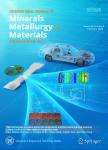Corrosion behavior of high-strength spring steel for high-speed railway
Corrosion behavior of high-strength spring steel for high-speed railway作者机构:Collaborative Innovation Center of Steel TechnologyUniversity of Science and Technology Beijing Beijing Engineering Technology Research Center of Special Steel for Traffic and Energy
出 版 物:《International Journal of Minerals,Metallurgy and Materials》 (矿物冶金与材料学报(英文版))
年 卷 期:2018年第25卷第5期
页 面:527-535页
核心收录:
基 金:financially supported by the National Natural Science Foundation of China (No.51474031)
主 题:high-strength spring steel corrosion resistance alloying elements rust layers evolution model
摘 要:The corrosion resistance and evolution of corrosion products in medium-carbon high-strength spring steels were investigated in a neutral salt spray(5 wt% Na Cl solution). A formation model of γ-Fe OOH and a transformation model describing the conversion of γ-Fe OOH to α-Fe OOH were constructed. The results indicated that, at the initial corrosion stage, the corrosion resistance was gradually improved with the addition of Cr; however, with the addition of alloying element V, the corrosion resistance decreased. These results were attributed mainly to the initial corrosion stage being closely related to the matrix microstructure parameters such as grain-boundary character and dislocation density. After the rust layer was formed at a later corrosion stage, the corrosion resistance was reinforced with the addition of Cr and V because Cr strongly influenced the composition, structure, and morphology of the corrosion products. The results presented herein show that Cr was conducive to the transformation of γ-Fe OOH into α-Fe OOH. Moreover, V and Cr exhibited obvious synergy and were enriched in the inner layer of the corrosion products.



